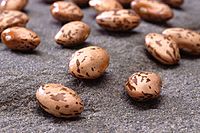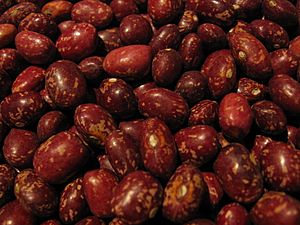Pinto bean facts for kids
 |
|
| Nutritional value per 100 g | |
|---|---|
| Energy | 598 kJ (143 kcal) |
|
26.22
|
|
| Sugars | 0.34 |
| Dietary fiber | 9.0 |
|
0.65
|
|
| Saturated | 0.109 |
| Monounsaturated | 0.106 |
| Polyunsaturated | 0.188 |
|
Protein
|
9.01
|
| Vitamins | Quantity
%DV†
|
| Vitamin A equiv. |
0%
0 μg |
| Vitamin A | 0 IU |
| Thiamine (B1) |
17%
0.193 mg |
| Riboflavin (B2) |
5%
0.062 mg |
| Niacin (B3) |
2%
0.318 mg |
| Vitamin B6 |
18%
0.229 mg |
| Folate (B9) |
43%
172 μg |
| Vitamin C |
1%
0.8 mg |
| Vitamin D |
0%
0 μg |
| Vitamin D |
0%
0 IU |
| Vitamin E |
6%
0.94 mg |
| Vitamin K |
3%
3.5 μg |
| Minerals | Quantity
%DV†
|
| Calcium |
5%
46 mg |
| Iron |
16%
2.09 mg |
| Magnesium |
14%
50 mg |
| Phosphorus |
21%
147 mg |
| Potassium |
15%
436 mg |
| Sodium |
16%
238 mg |
| Zinc |
10%
0.98 mg |
| Other constituents | Quantity |
| Water | 62.95 g |
| †Percentages estimated using US recommendations for adults. | |
The pinto bean is a type of common bean. It's famous for its cool speckled look, which is how it got its name! In Spanish, it's called frijol pinto, meaning "speckled bean," much like a pinto horse.
This bean is super popular in Northern Mexico and the Southwestern United States. People often eat them whole in a broth, or mashed up and then "refried." They're a common and yummy filling for burritos in Mexican cuisine. In South America, it's sometimes called poroto frutilla, which means "strawberry bean." In Brazil, it's known as feijão carioca. You can also eat young, unripe pinto beans as "green pinto beans."
Contents
How Pinto Beans Are Used
Pinto beans are a staple food in many parts of the world. Dried pinto beans are often soaked and then cooked, or you can buy them already canned. They are a key ingredient in many dishes, especially refried beans.
Pinto Beans in Popular Dishes
Pinto beans are a favorite in chili con carne. While other beans like kidney beans or black beans can be used, pinto beans are a top choice.
They are also a very important part of Brazilian cuisine. Beans, especially common beans, have been grown and eaten in Brazil since about 3000 BC! They are often served with starch-rich foods like rice, manioc, pasta, or potatoes. Pinto beans are also a huge part of Mexican cuisine.
In the Southern United States, pinto beans were once a main food, especially during winter. Some groups and churches still hold "pinto bean suppers" for fun gatherings and to raise money.
Types of Pinto Beans
There are several different kinds of pinto beans. Some well-known varieties include 'Burke', 'Hidatsa', and 'Othello'.
Alavese Pinto Bean

One special type is the alubia pinta alavesa, or the "Alavese pinto bean." This red pinto bean comes from Añana, a town in the Basque Country of northern Spain. Every October, they even have a special fair in Pobes just for this bean, called the Feria de la alubia pinta alavesa!
Cooking Pinto Beans
Cooking dried pinto beans can take a bit of time. Many people like to soak them first, which helps them cook much faster.
Cooking Times
If you don't soak them, you might boil them quickly for 10 minutes first. Then, they usually need to cook for two to three hours on a stove to become soft. If you use a pressure cooker, they cook much faster! Soaked beans might be ready in about 3 minutes, while unsoaked beans could take 20-45 minutes. Keep in mind that cooking times can change based on the beans themselves or how hard your cooking water is.
Pinto Bean Nutrition
Pinto beans are packed with good stuff for your body! They are a great source of protein, which helps build muscles. They also provide phosphorus and manganese, which are important minerals. Plus, they are very high in dietary fiber, which is good for your digestion, and folate, a type of B vitamin.
Healthy Meals with Pinto Beans
In places where meat might not be available, a meal of rice and pinto beans with cornbread or corn tortillas is often a main dish. This combination is great because it gives you all the essential amino acids your body needs. Corn has amino acids that beans don't have much of, and beans have amino acids that corn doesn't have much of. They complete each other perfectly!
Studies have also suggested that eating pinto beans might help lower levels of both "good" (HDL) and "bad" (LDL) cholesterol in your body. Pinto beans also contain a natural plant compound called coumestrol, which may have various health benefits.
See also
 In Spanish: Frijol pinto para niños
In Spanish: Frijol pinto para niños

